I'm trying to create a triangle mesh of a sphere surface and draw it with OpenGL 4.1.
This is the code that I'm currently using obtained from the second answer of that question, The vertex layout is [x, y, z, r, b, g, a] that's why there is 7 float foreach vertex:
std::vector<float> vertices;
std::vector<unsigned int> indices;
const float dLambda = 2 * glm::pi<float>() / meridianNumber;
const float dPhi = glm::pi<float>() / parallelNumber;
unsigned int lastVertex = 0;
for (int i = 0; i < parallelNumber; ++i) {
for (int j = 0; j < meridianNumber; ++j) {
std::cout << "lot: " << glm::degrees(j * dLambda);
std::cout << "\tlat: " << glm::degrees(i * dPhi);
std::cout << std::endl;
float lambda1 = j * dLambda;
float phi1 = i * dPhi;
float lambda2 = j+1 == parallelNumber ? 2 * glm::pi<float>()
: (j+1) * dLambda;
float phi2 = i+1 == meridianNumber ? glm::pi<float>()
: (i+1) * dPhi;
// vertex 1
vertices.emplace_back(cosf(lambda1) * sinf(phi1) * radius);
vertices.emplace_back(cosf(phi1) * radius);
vertices.emplace_back(sinf(lambda1) * sinf(phi1) * radius);
vertices.emplace_back(0.5f);
vertices.emplace_back(1.0f);
vertices.emplace_back(1.0f);
vertices.emplace_back(1.0f);
// vertex 2
vertices.emplace_back(cosf(lambda1) * sinf(phi2) * radius);
vertices.emplace_back(cosf(phi2) * radius);
vertices.emplace_back(sinf(lambda1) * sinf(phi2) * radius);
vertices.emplace_back(0.5f);
vertices.emplace_back(1.0f);
vertices.emplace_back(1.0f);
vertices.emplace_back(1.0f);
// vertex 3
vertices.emplace_back(cosf(lambda2) * sinf(phi1) * radius);
vertices.emplace_back(cosf(phi1) * radius);
vertices.emplace_back(sinf(lambda2) * sinf(phi1) * radius);
vertices.emplace_back(0.5f);
vertices.emplace_back(1.0f);
vertices.emplace_back(1.0f);
vertices.emplace_back(1.0f);
// vertex 4
vertices.emplace_back(cosf(lambda2) * sinf(phi2) * radius);
vertices.emplace_back(cosf(phi2) * radius);
vertices.emplace_back(sinf(lambda2) * sinf(phi2) * radius);
vertices.emplace_back(0.5f);
vertices.emplace_back(1.0f);
vertices.emplace_back(1.0f);
vertices.emplace_back(1.0f);
indices.emplace_back(lastVertex);
indices.emplace_back(lastVertex+1);
indices.emplace_back(lastVertex+2);
indices.emplace_back(lastVertex+1);
indices.emplace_back(lastVertex+3);
indices.emplace_back(lastVertex+2);
lastVertex += 4;
}
But I am doing something wrong because that's what I'm drawing:

the code that I'm using to draw is:
GLCall(glDrawElements(
GL_TRIANGLES,
indicesNumber,
GL_UNSIGNED_INT,
(const void*) 0
));
EDIT 1: The VAO settings are pretty complicated because I wrote a little layer of abstraction over opengl... I have a class called VertexBuffer that creates, keeps alive and destroys an OpenGL array buffer. Another class IndexBuffer is very similar to the previous one that manages the Element array buffer. This two classes are very simple to use they can be constructed, binded, unbinded and destroyed, nothing more. There is a third class that represents a layout of a single vertex in an OpenGL vertex buffer; this class called VertexLayout contains all the data that is necessary to call the glVertexAttribPointer.
hpp:
class VertexLayout {
private:
struct Element {
unsigned int type;
unsigned int count;
unsigned char normalized;
size_t typeSize;
Element(
unsigned int type, unsigned int count, unsigned char normalized,
size_t typeSize
);
};
std::vector<Element> elements;
unsigned int stride;
public:
VertexLayout();
template<typename T>
VertexLayout &push(unsigned int count, unsigned char normalized = GL_FALSE){
std::fputs(
"this function has to be implemented for desired type",
stderr
);
assert(false);
return *this;
}
const std::vector<Element> &getElements() const;
unsigned int getStride() const;
};
cpp:
template<>
VertexLayout &VertexLayout::push<unsigned int>(
unsigned int count, unsigned char normalized
) {
elements.emplace_back(
GL_UNSIGNED_INT, count, normalized, sizeof(unsigned int)
);
stride += count * sizeof(unsigned int);
return *this;
};
template<>
VertexLayout &VertexLayout::push<unsigned char>(
unsigned int count, unsigned char normalized
) {
elements.emplace_back(
GL_UNSIGNED_BYTE, count, normalized, sizeof(unsigned char)
);
stride += count * sizeof(unsigned char);
return *this;
};
template<>
VertexLayout &VertexLayout::push<float>(unsigned int count, unsigned char normalized){
elements.emplace_back(GL_FLOAT, count, normalized, sizeof(float));
stride += count * sizeof(float);
return *this;
}
VertexLayout::Element::Element(
unsigned int type, unsigned int count,
unsigned char normalized, size_t typeSize
) : type(type), count(count), normalized(normalized), typeSize(typeSize) {}
const std::vector<VertexLayout::Element> &VertexLayout::getElements() const {
return elements;
}
unsigned int VertexLayout::getStride() const {
return stride;
}
VertexLayout::VertexLayout() : stride(0) {}
So an instance of VertexLayout should be created foreach VertexBuffer object and foreach opengl attribute should be called a push<type>(numberOfElementOfThatType).
The fourth and last class is the VertexArray class that represents a VAO: this last class keeps trace of all the VertexBuffer and IndexBuffer objects that are connected to the vao and sets the layout calling glVertexAttribPointer when a VertexBuffer is added using the following method:
void VertexArray::addBuffer(
const VertexBuffer &buffer, const VertexLayout &layout
) {
GLCall(glBindVertexArray(id));
buffer.bind();
const auto &elements = layout.getElements();
size_t offset = 0;
for (unsigned int i = 0; i < elements.size(); ++i) {
const auto &element = elements[i];
GLCall(glEnableVertexAttribArray(i));
GLCall(glVertexAttribPointer(
i, element.count, element.type, element.normalized,
layout.getStride(), (const void *)offset
));
offset += element.count * element.typeSize;
}
vertexBuffers.emplace_back(buffer);
}
GLCall is a macro that does nothing in release while in debug is clears the OpenGL erros and prints the new errors.
EDIT 2: This is the class VertexBuffer that represents one VBO:
hpp
class VertexBuffer {
private: // static
static std::map<unsigned int, unsigned int> references;
private: // member
unsigned int rendererID;
public:
VertexBuffer();
VertexBuffer(
const void *data, unsigned long size,
unsigned int usage = GL_STATIC_DRAW
);
VertexBuffer(const VertexBuffer &oth);
VertexBuffer &operator=(const VertexBuffer &rhs);
~VertexBuffer();
void bind() const;
void unbind() const;
};
cpp:
std::map<unsigned int, unsigned int> VertexBuffer::references;
VertexBuffer::VertexBuffer(
const void *data,
unsigned long size,
unsigned int usage
) {
GLCall(glGenBuffers(1, &rendererID));
GLCall(glBindBuffer(GL_ARRAY_BUFFER, rendererID));
GLCall(glBufferData(GL_ARRAY_BUFFER, size, data, usage));
references.insert_or_assign(rendererID, 1);
}
VertexBuffer::VertexBuffer(const VertexBuffer &oth) {
if (oth.rendererID != 0){
auto ref = references.find(oth.rendererID);
assert(ref != references.end());
ref->second++;
}
rendererID = oth.rendererID;
}
VertexBuffer &VertexBuffer::operator=(const VertexBuffer &rhs) {
if (rendererID != 0) {
auto refs = references.find(rendererID);
assert(refs != references.end());
if (--refs->second == 0) {
GLCall(glDeleteBuffers(1, &rendererID));
references.erase(refs);
}
}
if (rhs.rendererID != 0){
auto ref = references.find(rhs.rendererID);
assert(ref != references.end());
ref->second++;
}
rendererID = rhs.rendererID;
return *this;
}
VertexBuffer::VertexBuffer() : rendererID(0) {}
VertexBuffer::~VertexBuffer() {
if (rendererID != 0) {
auto ref = references.find(rendererID);
assert(ref != references.end());
if (--ref->second == 0) {
GLCall(glDeleteBuffers(1, &rendererID));
references.erase(ref);
}
}
}
void VertexBuffer::bind() const {
GLCall(glBindBuffer(GL_ARRAY_BUFFER, rendererID));
}
void VertexBuffer::unbind() const {
GLCall(glBindBuffer(GL_ARRAY_BUFFER, 0));
}
In the sphere I have only one big buffer that contains both positions and colors.